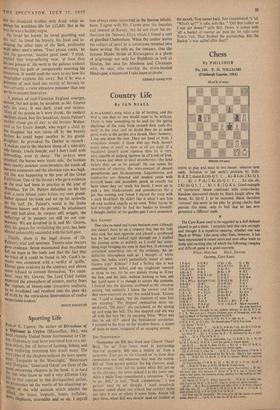Chess
By PHILIDOR No. 110. P. H. WILLIAMS (Pittsburgh Gazette, 1911)
BLACK (4 men)
WHITE (10 men)
WHITE to play and mate in two moves: solution next week. Solution to last week's problem by Sells:
R-K B 7, threat Kt (6)-Q 5. Kt-B 4 ch; 2 Kt-Q 3, I . Kt x P ch; 2 Kt (4)--Q 5. I . .. Kt else ch;
2 Kt (6)-Q 5. 1 ... Kt x R; 2 Q-K 4. Good example of 'correction' theme combined with cross-checks. Random discovered checks by Black knight allow the threat, Kt (6)-Q 5, to be executed. Black therefore 'corrects' this error in his play by giving checks that prevent this mate. only to find that he has now permitted a different mate.
The Coro Kann used to be regarded as a dull defence played to get a draw. I certainly held this view strongly and thought it a repulsive opening, whether one was Black or White. Like most other lines, however, it has been rejuvenated in recent years and now often leads to lively and exciting play of which the following complex and difficult game is a good example.
White, M1KLNAS Black, BANNIK p_01303pening, Caro Kann
I? Kt x Kt 1 P-K 4 0 x Kt 2 P-Q 4 P-04 IS Q-13 4!(i) Kt-K 2
3 P-K 5 (a) li -13 l9 Kt-R5 5 4 P-115 (j) 4 Kt-K 2 P-K 3 20 Ku x P K-B 2 5 Kt-B 4 P-K R 3 (b) 21 13-K 3 P-Kt 4 6 P-Q 13 3 P-B 4 22 Q-K 2 Q-K B 4 7P x P? (c) Kt4) B 3? (4) 23 R-Q 2 (k) KBTI3t32 87
24 Q R-0 1 P-R 3
9 0"3 -0 Q13--K8 15 (e) 25 1'-Kt 3 B-K 4
10 Kt-Q 2 P-K Kt 4 26 R-Q 7 11 B x 11 P x 13(f) 27 Kt-Kt 2! Kt-Q 4 12 Kt-R 5 Q x P 28 Kt-R 4 Q-R 4 13 Kt-B 4! Q x P 29 B-B I Q-K 1 14 Q-K 2 P-Kt 5 30 R (I) x Kt! Ps 15 Kt-Kt 3 P-B 4 (e) 31 Q x K Kt P Black exceeded
16 R-Q 1 (h) Kt-K 4? the time limit (m) (a) Generally thought to be slightly inferior to Kt-Q B 3 or P x P. We now get a French Defence type of formation. with the gain to Black of having developed his 0 B.
(b) Unnecessary, since 6 P-K Kt 4 is met by 6 . . B-K 5; P-K B 3?, ft 5 ch). lie should play P-Q 11 4 at once.
(c) Better 7 13-Q 3. (d) Wrong order. 7 . 0-B 2!; 8 B-Kt 5 ch, Kt-B 3; 9 0-O,
B x P; 10 Q-K 2, Kt-K 2; gives Black an excellent game. (e) Now 9 ... Kt x P is met by 13 x P. followed by Kt x Q P and 9 .. Q x P by 10 R-K I.
(f) 11 P x Kt; is preferable, e.g. 12 B-B 2, Q x P; 13 Kt-B 3, Q-B 2; 14 R-K 1 and the game is about equal.
(g) If 15 . Kt-K 4; then 16 Kt x Kt. Q x Kt: I7 B-K 3, :Meat 13-Q 4 and White has much the better game.
(h) ii 16 13-K 3, then 16 . Q-K 2. Text threatens 17 13-K 3 after which Q-K 2 is refuted by Kt-Q 6 ch. Black's best answer is 16 . . P-Kt 41; 17 Kt-R 3; P-R 3; though White's position is still superior.
(i) Threatening 17 B-B 41, Q it B; 18 Q x P ch Kt-K 2
118 B-K 2; 19 Kt x BP); 19 Kt-R 5! and wins.
(j) Curious echo of his 14th move, again discovering a W Kt He must play this because of threat of 13-B 4, but it leaves him- with a lost game, his position being inferior for the ending as Wei' as the middle game. (k) Better 23 R-Q 7! White feared 23 ... P-K 4; 'n reply, but this is met by 24 Q it Q Kt PI Text is, however, good enough. (1) 26... B x Kt; is essential. but after 27 14 x B White should still win, e.g. 27 . . . Q R-B 1; 28 13-Q 6 K K-K I ; 29 Q-K 3, with threat of Q it P or Q-R 7 or Q-Kt 6.
(m) One way of resigning! He must give up the queen to avoid
mate, since 31 Q-K 3; is met by 32 Q-Kt 6 mate.














































 Previous page
Previous page